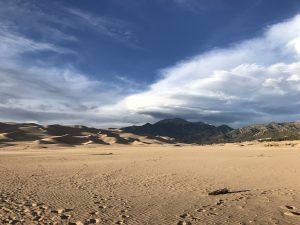GREAT SAND DUNES – With encroaching light pollution, agricultural water diversion, and climate change, managers at the Great Sand Dunes National Park and Preserve, the iconic park located in the San Luis Valley outside of Hooper, Colorado, have increasing reasons to monitor the land outside the park’s borders.
“If we’re in the natural business,” says Fred Bunch, Resources Manager for the Great Sand Dunes, “as natural as possible is best.”

Looking over dry Medano Creek to the sand dunes. Photo Heather Rolph
The San Luis Valley is approximately 8,000 square miles of high altitude desert, ringed by the Sangre de Cristo mountains to the east, the San Juan mountains to the west, and the tip of the Sawatch range in the north. With under 50,000 people in the entire valley, the park is one of the darkest and quietest in the country.
People have a “right to starlight,” says Bunch. “Half the park is after dark.”
He’s pursuing certification as a Dark Sky Place from the International Dark-Sky Association (IDA), which would give the park a certain degree of legal power to prevent nearby light pollution.
Bunch spends clear moonless nights up on the dunes, measuring darkness levels with a hand-held light quality meter. On a logarithmic scale that maxes out at 23, the Great Sand Dunes have measured up to 22. The park has been proactive at asking nearby businesses to remove bright neon signs, and changing their own lighting systems to scatter less light. They’ve even prevented a brightly lit grillhouse from being erected near the park’s borders.
“Inspiration,” Bunch says about the importance of the night sky. “Something greater than just piles of sand.”
But there are other reasons to pursue a Dark Sky Place certification. Specifically, tourism.
Five of the six counties that make up the San Luis Valley are among the poorest in Colorado. The state has a per capita income of more than $30,000. Saguache and Alamosa counties, which border the park, have per capita incomes under $19,000.
Visitors to the Great Sand Dunes, says Bunch, have doubled in the past four years, reaching a record high of nearly 487,000 in 2017. Annual visitor spending in the surrounding community was $29 million in the past year, according to economic modeling by the National Park Service, which supported 408 jobs. Most of the visitors come from Front Range metro areas, where light pollution is bad enough that the Milky Way is no longer reliably visible. Other factors, however, also play a role in tourist visits.
“People stay longer if there’s water,” says Bunch, referring to the seasonal Medano Creek that must be crossed to enter the dunes. Families flock to the creek’s wave-like surges, and tend to remain longer in the park – and thus the surrounding community – when there’s higher water flow.
But Medano’s water flow is less than it could be due to private water rights on the creek dating from the 1890s, says park geologist Andrew Valdez. From the 15th of May through the 15th of July – right when the creek has the highest flow – a ranch on the other side of the mountains diverts 1,000 acre-feet of water, 20% of the creek’s annual flow, for agricultural use.
And water flow could become even more uncertain as climate change accelerates. Average yearly temperatures at Great Sand Dunes could increase by as much as four degrees Celsius by 2030, says Bill Battaglin, a Research Hydrologist with the U.S. Geological Survey who has been working on climate modeling for National Parks. Precipitation is also expected to increase, but higher temperatures mean less of a snowpack. And that means less spring runoff and decreased creek flow.
“I look across the landscape and can’t tell what year it is,” says Bunch. “Every time I go to Denver it’s gotten larger, but the park’s the same.”
But as the population of the San Luis Valley increases and climate change accelerates, that may no longer be true.
“We need to protect things that are pristine,” says Bunch. “Any degradation of that resource is very noticeable.”

